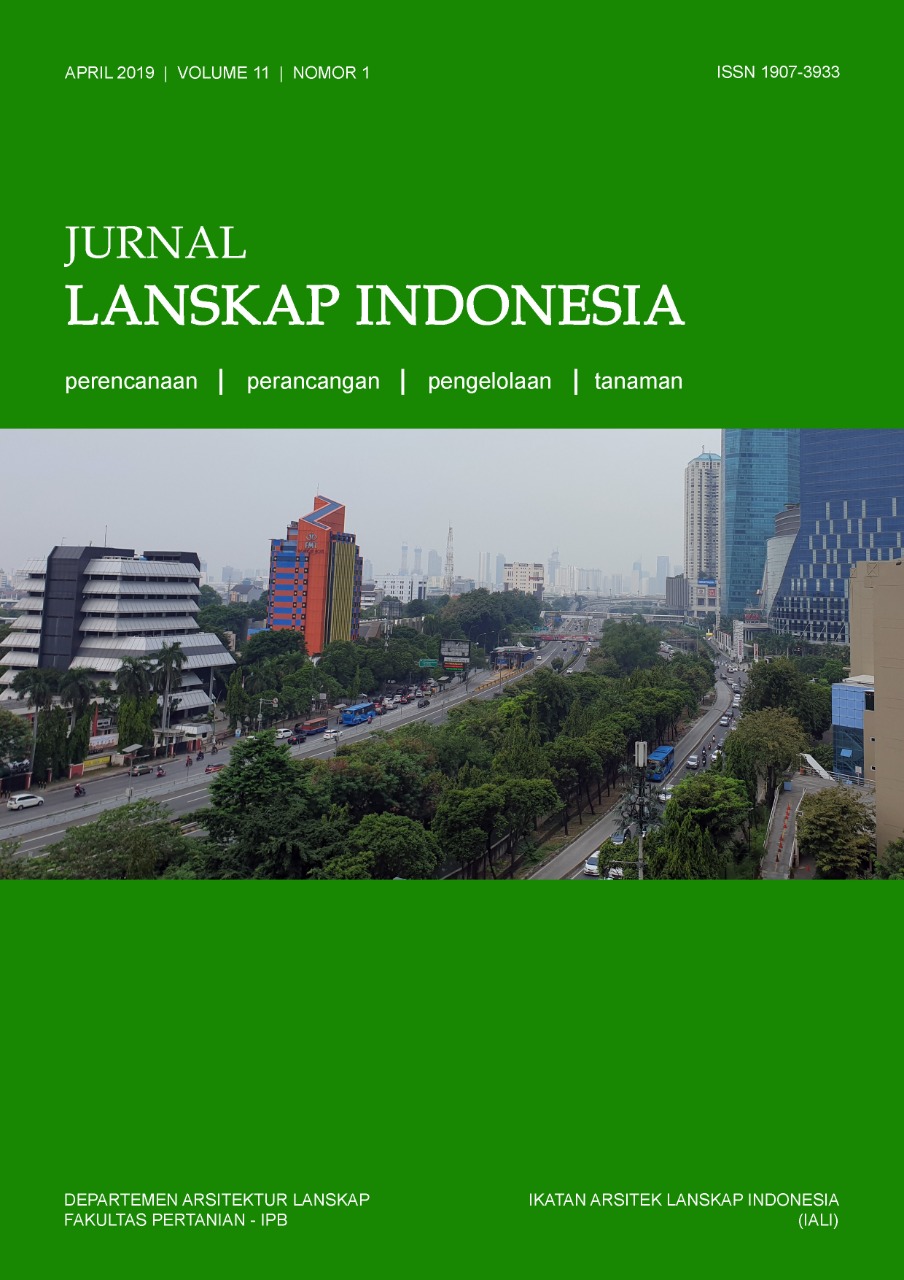Tiga Kelompok Pengunjung berdasarkan Durasi Kunjungan dan Karakteristik Taman
Abstract
The characteristics of urban parks can attract and makes visitors want to stay longer. The long duration of the visit in the urban park can increase visitor’s attitude toward a place. The longer they stay, the stronger the sense of belonging they have in that place. This current study wants to find out how the grouping of visitors in the urban park was based on the duration of the visit and the characteristics of the park. Data collection was carried out by distributing online questionnaires and the data of 211 respondents was processed for this study. Data was processed by explanatory qualitative method, with open coding, axial coding, and selective coding analyses. The result showed that there were three large groups of visitors in the park, who had different level of attitudes toward urban parks, namely relaxation, escape, and audience group. Audience group was assumed having the highest level of attitude toward urban parks than others. In order to increase the duration of the visit, the urban parks require attractions that are in demand by the audience.
Keywords: duration of the visit, place characteristics, sense of place, urban parks
Downloads
References
Binarti, F. et al. 2008. ‘Peranan Unsur-Unsur Ruang Terbuka pada Tingkat Kenyamanan Termal Outdoor: Antara Persepsi dan Pengetahuan’, Jurnal Arsitektur KOMPOSISI, 12(1): 41–52.
Creswell, J. W. 2007. Qualitative Inquiry and Research Design: Choosing among Five Approaches. 2nd edn. London: SAGE Publications.
Fauziah, A., Santosa, I. and Wahjudi, D. 2016. ‘Thematic Concept on The Physical Element of Open Space Towards People’s Place Attachment in The City of Bandung’, Global Journal of Arts, Humanities and Social Sciences, 4(7): 48–65.
Halpenny, E. A. 2010. ‘Pro-Environmental Behaviours and Park Visitors : The Effect of Place Attachment’, Journal of Environmental Psychology. Elsevier Ltd, 30(4): 409–421. doi: 10.1016/j.jenvp.2010.04.006.
Ingkadijaya, R. et al. 2016. ‘Aktivitas Wisata Pilihan Keluarga Perkotaan’, Jurnal Khasanah Ilmu, 7(1): 39–44.
Najafi, M. and Shariff, M. K. B. M. 2011 ‘The Concept of Place and Sense of Place In Architectural Studies’, International Journal of Human and Social Sciences, 6(3): 187–193.
Porajouw, E. F., Poluan, R. J. and Mastutie, F. 2017. ‘Efektivitas Ruang Terbuka Publik di Kota Tomohon’, Spasial, 4(1): 136–148.
Prakoso, S. and Dewi, J. 2017. ‘Rasa Kelekatan Anak pada Ruang Publik Terpadu Ramah Anak (RPTRA)’, NALARs, 17(1): 1–10.
Relph, E. 1976. Place and Placelessness. London: Pion Limited.
Schipperijn, J. et al. 2010. ‘Factors influencing the use of green space : Results from a Danish national representative survey’, 95: 130–137. doi: 10.1016/j.landurbplan.2009.12.010.
Shamai, S. 1991. ‘Sense of Place : an Empirical Measurement’, Geoforum, 22(3): 347–358.
Smaldone, D. 2006. ‘The Role of Time in Place Attachment’. Di dalam Proceedings of the 2006 Northeeastern Recreation Research Symposium. Hlm 47–56.
Stedman, R. C. 2003. ‘Is It Really Just a Social Construction ?: The Contribution of the Physical Environment to Sense of Place Society & Natural Resources’, Society & Natural Resources, 16: 671–685. doi: 10.1080/08941920309189.
Wendel, H. E. W., Zarger, R. K. and Mihelcic, J. R. 2012. ‘Accessibility and Usability : Green Space Preferences , Perceptions, and Barriers in a Rapidly Urbanizing City in Latin America’, Landscape and Urban Planning. Elsevier B.V., 107(3):. 272–282. doi: 10.1016/j.landurbplan.2012.06.003.
Whiting, J. W. et al. 2017. ‘Outdoor Recreation Motivation and Site Preferences across Diverse Racial/Ethnic Groups : A Case Study of Georgia State Parks’, Journal of Outdoor Recreation and Tourism. Elsevier Ltd, 18: 10–21. doi: 10.1016/j.jort.2017.02.001.
This journal permits and encourages authors to post items submitted to the journal on personal websites or institutional repositories both prior to and after publication, while providing bibliographic details that credit, if applicable, its publication in this journal. However, after the article is submitted and published in this journal, it is fully copyrighted by the Jurnal Lanskap Indonesia or JLI. If excerpts from other copyrighted works are included, the author must obtain written permission from the copyright owner and give credit to the source in the article. Then, the writer or reader is allowed to copy, share, and redistribute articles/material in any form. But it must still include the appropriate source and credit because the article in this journal is licensed by Creative Commons Attribution 4.0 International License (CC BY 4.0).
I. Proposed Policy for Journals That Offer Open Access
Authors who publish with this journal agree to the following terms:
- Authors retain copyright and grant the journal right of first publication with the work simultaneously licensed under a Creative Commons Attribution License that allows others to share the work with an acknowledgement of the work's authorship and initial publication in this journal.
- Authors are able to enter into separate, additional contractual arrangements for the non-exclusive distribution of the journal's published version of the work (e.g., post it to an institutional repository or publish it in a book), with an acknowledgement of its initial publication in this journal.
- Authors are permitted and encouraged to post their work online (e.g., in institutional repositories or on their website) prior to and during the submission process, as it can lead to productive exchanges, as well as earlier and greater citation of published work (See The Effect of Open Access).
II. Proposed Policy for Journals That Offer Delayed Open Access
Authors who publish with this journal agree to the following terms:
- Authors retain copyright and grant the journal right of first publication, with the work after publication simultaneously licensed under a Creative Commons Attribution License that allows others to share the work with an acknowledgement of the work's authorship and initial publication in this journal.
- Authors are able to enter into separate, additional contractual arrangements for the non-exclusive distribution of the journal's published version of the work (e.g., post it to an institutional repository or publish it in a book), with an acknowledgement of its initial publication in this journal.
- Authors are permitted and encouraged to post their work online (e.g., in institutional repositories or on their website) prior to and during the submission process, as it can lead to productive exchanges, as well as earlier and greater citation of published work (See The Effect of Open Access).



























